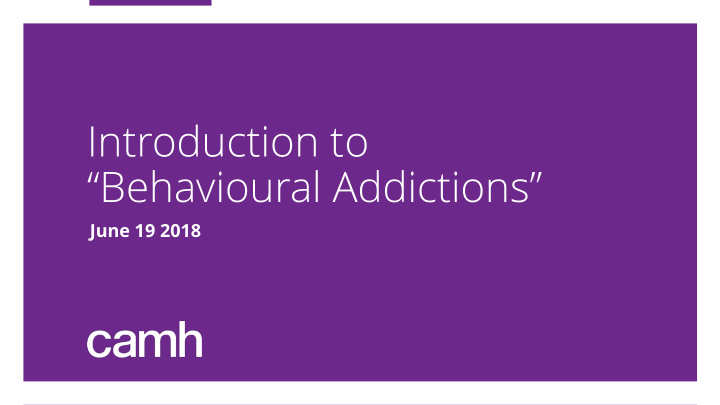



Introduction to “ Behavioural Addictions” June 19 2018
Learning Objectives 1. Describe behavioural addictions and their impacts 2. Recognize co-occurring issues 3. Name relevant screening and assessment tools 4. Identify evidence-informed treatment approaches and referral resources
Who’s in the room?
Addicted to what?
Common features?
Impact?
• 49 problem gambling funded agencies • Services are free and confidential • Often offer one-on-one and group counselling • Available for anyone affected by PG, including family members
• Live information and referral specialists • Free, confidential, available 24/7 • Can provide info about local treatment services specific to your client’s needs and the type of behavioural addiction involved
1. What other supports have been helpful with navigating the treatment system and connecting clients with the right services? 2. When making a referral for a client with a behavioural addiction, what is helpful to emphasize to the client?
Treatment approaches – PG example Self-help • Gamblers Anonymous (GA) • GAM-Anon • Self-help tools approaches • Self-exclusion Harm • Setting money or time limits • Focusing on impacts of gambling (finances, relationships, etc.) • Abstaining from one form of gambling or taking a break from gambling to assess reduction its impact and gain control • Responsible Gambling approach • Functional analysis - identifying triggers, related thoughts and feelings; identifying negative consequences associated with gambling CBT • Addressing cognitive distortions such as gambling-related myths • Relapse prevention
Treatment approaches – PG example Motivational • Helping to elicit behavioural change and explore motivation through open questions, affirmations, reflections, summaries • Exploring benefits of change and eliciting change talk Interviewing • Setting a gambling goal and exploring how client’s values and other life goals relate to the gambling goal • Increasing self-awareness of thoughts and feelings in a nonjudgmental manner; Mindfulness helps to control impulses • “Urge surfing” • One-on-one or group counseling for family members (even if the person with the Family gambling problem is not in treatment) • Linking to other services to help protect finances, etc. • Helping to restore trust, process what the family has gone through, learn support communication strategies
Case Study At your tables read the case study and answer the questions as a group. 1. What mental health and addiction issues would you screen for? 2. What are the signs that the person may be experiencing a behavioural addiction? What screener would you use? 3. What treatment strategies would you apply (specifically to address the problematic behaviour)? 4. What resources/supports would you utilize?
Questions? Please contact us with ANY questions: Sarah.waldman@camh.ca Matthew.tsuda@camh.ca
Thank You
Recommend
More recommend